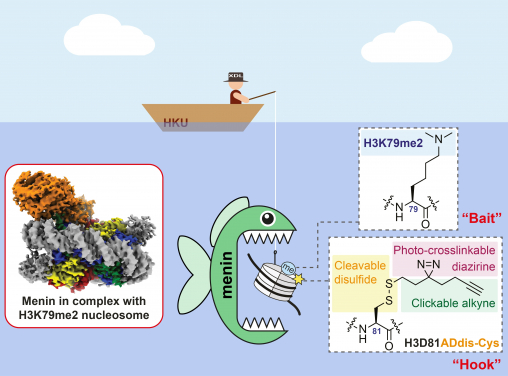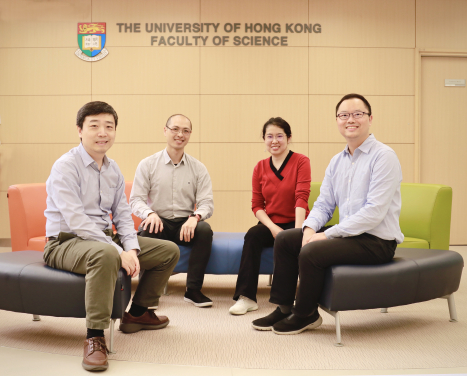Media
HKU Chemical Biologists decode a histone mark
important for gene regulation program that go awry in cancer
17 Feb 2023

Figure 2. The research team chemically synthesises an intact nucleosome with an upgraded tri-functional “hook” and H3K79me2 as the “bait”. Using this new technology, the team successfully identified a protein called menin as the “reader” of H3K79me2. (Image credit: Xiang David Li Group – The Laboratory of Chemical Epigenetics)

HKU Chemical Biologists decode a histone mark important for gene regulation program that go awry in cancer. The research team members include: (from left) Dr Yuanliang ZhAI, Dr Jason Wing Hon WONG, Dr Xiucong BAO and Professor Xiang David LI.

Figure 2. The research team chemically synthesises an intact nucleosome with an upgraded tri-functional “hook” and H3K79me2 as the “bait”. Using this new technology, the team successfully identified a protein called menin as the “reader” of H3K79me2. (Image credit: Xiang David Li Group – The Laboratory of Chemical Epigenetics)
- 1 / 2
- 2 / 2
A research team from the University of Hong Kong (HKU) led by Professor Xiang David LI from the Department of Chemistry in collaboration with Dr Yuanliang ZHAI from the HKU School of Biological Sciences and Dr Jason Wing Hon WONG and Dr Xiucong BAO from the HKU School of Biomedical Sciences recently made a key breakthrough in understanding how genetic information encoded in our DNA is 'read' and why errors in 'reading' such information can often lead to developmental defects or cancers. The findings were recently published in Science.
Each type of cell in the human body (with some exceptions) contains exactly the same DNA sequence known as genes. Therefore, to make a specific cell type (e.g., a stem cell, a neuron), each cell needs to carefully 'choose' which genes to express. This fundamental process is regulated by diverse modifications of histone proteins, which were previously thought as mere spools for packaging DNA in the nucleus of our cells. We now know that these histone modifications are tags or marks on chromatin that function as master switches for the regulation of genes — they determine which sets of genes in a cell should be 'ON' or 'OFF' at the right time and to the right extent. Misregulation of this fundamental process underlies many severe human diseases such as cancers.
Different types of histone marks act as cellular signals to control various chromatin-associated machineries that regulate gene expression, DNA replication, and damage repair. One of the challenges in chromatin biology is how particular histone marks are interpreted to achieve their biological function. To answer this question, it is essential to find the 'readers', a class of proteins that recognise specific histone marks and 'translate' them by turning the expression of genes up or down accordingly.
However, 'readers' of many histone marks are still unknown, which limits our ability to understand their roles in gene regulation. A long-standing interest of Professor Li’s lab is the development of novel chemical approaches to identify histone 'readers' that might be difficult to find using traditional biological methods. One such method uses a peptide containing a histone mark (i.e., a small fragment of histone protein) that acts as the 'bait' to 'fish' for 'readers' that recognise the mark. "The key to success is not only the 'bait' but also a specially designed 'hook' that is equipped with a light-activated chemical group to capture the 'readers' upon exposure to UV light," explained Professor Li.
In this study, the team focused on a methylation mark at histone H3 lysine 79 (H3K79me2). In human cells, this mark is found in actively expressed genes. Loss of H3K79me2 in mammalian embryos can lead to multiple developmental abnormalities, including impaired growth, cardiac dilation, and death. On the other hand, H3K79me2 has been found at abnormally high levels and in the wrong places (e.g., cancer-promoting genes) in a variety of cancers such as childhood leukaemia.
Despite its biological significance in gene regulation, the mechanism of how this mark is 'translated' is unclear, as the 'readers' of H3K79me2 have not been found since its discovery 20 years ago. In fact, over the years, many labs have tried various approaches to look for these 'readers'. "It is a great challenge to identify H3K79me2 “readers”, even with our previously developed novel chemical approaches," said Professor Li. There are two major hurdles to overcome. First, 'reading' the marks may involve not only the mark itself but also the whole histone and even the histone-DNA complex called a nucleosome. In other words, recognising H3K79me2 by its 'readers' may require a native nucleosome- or chromatin-context. Second, the interaction between the 'readers' and H3K79me2 can be weak or even transient and thereby easily lost during the 'fishing' process.
"To capture H3K79me2 “readers”, we must upgrade our 'bait' and 'hook',“ said Li. But it was not trivial. Li's lab spent more than five years developing their new tool. Instead of using a small fragment of the histone protein, they chemically synthesised an intact nucleosome with an upgraded tri-functional 'hook' and H3K79me2 as the 'bait' (Figure 2). Using this new technology, the team successfully identified a protein called menin as the 'reader' of H3K79me2.
To understand how menin 'reads' the H3K79me2 mark, the team adopted a cutting-edge technology called cryo-electron microscopy to visualise the molecular details of this interaction. "Unravelling the details of how menin binds H3K79 methylation is key to designing new drugs to treat cancers associated with misregulated H3K79me2," said Professor Li.
The pioneering work by Li and co-workers have advanced our understanding of the fundamental biological processes of gene regulation. These findings also open new opportunities for developing novel therapeutic agents to treat human diseases caused by abnormal levels of H3K79 methylation.
The journal paper can be accessed here: https://www.science.org/doi/10.1126/science.adc9318
Learn more about the research group of Dr Xiang David Li: https://xianglilab.com/
Images download and captions: https://www.scifac.hku.hk/press
For media enquiries, please contact Ms Casey To, External Relations Officer (Tel: 3917-4948; email: caseyto@hku.hk) and Ms Cindy Chan, Assistant Communications Director of Faculty of Science (Tel: 3917-5286; email: cindycst@hku.hk).
